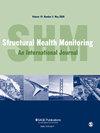A temperature-driven approach for quantitative assessment of strengthening effect of continuous bridges using structural health monitoring data
IF 5.7
2区 工程技术
Q1 ENGINEERING, MULTIDISCIPLINARY
Structural Health Monitoring-An International Journal
Pub Date : 2023-07-03
DOI:10.1177/14759217231181882
引用次数: 0
Abstract
The stiffness degeneration of small to medium span bridges has been increasingly observed in recent years, and it has become a major concern of government and bridge owners. A quantitative evaluation method for the bridge performance with strengthening measures is highly desired. Due to the advantages of uninterrupted traffic and long-term tracking capability, a temperature-driven approach for characterization of the correlation pattern between bridge temperature-induced strains and bridge status was proposed in the present study by using structural health monitoring data. First, a theoretical solution of the simplified bridge model was derived to establish the correlation between the stress and deterioration extent under temperature gradient load. After a numerical simulation that combines the thermal–structural interaction analysis and the vehicle–bridge interaction analysis, the strain range was proposed as an assessment index to ensure the stability and effectiveness of the evaluation results. Next, the Generalized Extreme Studentized Deviate method was used for detecting the outliers. The statistical results of the assessment index for different strengthening methods were compared to evaluate the associated strengthening efficiency, and the associated equivalent section height was calculated for visualizing the bridge condition after strengthening measures were taken. The results demonstrated that the proposed temperature-driven method was able to quantitatively evaluate the bridge strengthening effects with a high efficiency.基于结构健康监测数据的连续桥梁加固效果的温度驱动定量评估方法
近年来,中小型桥梁的刚度退化现象越来越多,已成为政府和桥梁业主关注的焦点。人们迫切需要一种通过加固措施对桥梁性能进行定量评估的方法。由于交通不中断和长期跟踪能力的优势,本研究提出了一种温度驱动的方法,通过使用结构健康监测数据来表征桥梁温度引起的应变与桥梁状态之间的相关性模式。首先,推导了简化桥梁模型的理论解,以建立温度梯度荷载下应力与退化程度之间的相关性。在将热-结构相互作用分析和车辆-桥梁相互作用分析相结合的数值模拟后,提出了应变范围作为评估指标,以确保评估结果的稳定性和有效性。接下来,使用广义极值研究偏差法来检测异常值。对不同加固方法的评估指标的统计结果进行比较,以评估相关加固效率,并计算相关等效截面高度,以可视化采取加固措施后的桥梁状况。结果表明,所提出的温度驱动方法能够高效地定量评价桥梁加固效果。
本文章由计算机程序翻译,如有差异,请以英文原文为准。
求助全文
约1分钟内获得全文
求助全文
来源期刊
CiteScore
12.80
自引率
12.10%
发文量
181
审稿时长
4.8 months
期刊介绍:
Structural Health Monitoring is an international peer reviewed journal that publishes the highest quality original research that contain theoretical, analytical, and experimental investigations that advance the body of knowledge and its application in the discipline of structural health monitoring.

 求助内容:
求助内容: 应助结果提醒方式:
应助结果提醒方式:


